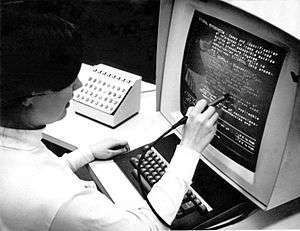IBM System/370 Model 168
The IBM System/370 Model 168 and Model 158[1] were both announced on August 2, 1972.[2] Prior 370 systems had not "offered virtual storage capability, which was to be a hallmark of the 370 line," and some said that the 168 and 158 were the first "real 370" products.[3] By contrast, "in 1972, the System/370 Advanced Function was released and had new Address Relocation Hardware and now supported four new operating systems (VM/370, DOS/VS, OS/VS1, OS/VS2)."[4]

said that
"the console used a CRT display,
a keyboard, and a light pen."
The 168's manual says "light pen is standard."
 | |
| Manufacturer | International Business Machines Corporation (IBM) |
|---|---|
| Product family | System/370 |
| Release date | August 2, 1972 |
| Discontinued | September 15, 1980 |
| Memory | up to eight megabytes of integrated monolithic processor storage |
| Website | Official website IBM Archives |
The 158 and 168 were withdrawn on September 15, 1980.
Features
Main memory
Main memory for the Model 168, which was "four-way doubleword interleaved," could be 1 to 8 megabytes, with offerings selectable in increments of one megabyte.[5]
Newer technology than that of the 370/165, which had been introduced 2 years prior, used "monolithic, instead of magnetic core" memory,[5] resulting in a system which was faster and physically smaller than a Model 165.[5]:pp.3–5
System console
The newly introduced IBM 3066 Model 2 System console
- included a light pen[NB 1]
- replaced "most switch, pushbutton, and indicator functions"[NB 2][5]:p.32
- as with the 165's Model 1, had a microfiche document viewer,[NB 3] a feature introduced for the 360/85's console.[NB 4]
A console printer (up to 85 characters per second) to provide hard copy was optional when the console was in display mode, and required when it was in printer-keyboard mode.
Disk storage
The newly introduced Model 11 of IBM's 3330 family of disk drives, featuring removable disk packs, has double the capacity of the prior 100-megabyte offerings.[NB 5][NB 6] It can't be attached to a 370/165.[5]:p.94
Multiprocessing
Both the 370/168 and the 370/158 had MP (multiprocessing) models that offered "tightly coupled multiprocessing.[1]
The 168 was described[2] as having "two types of multiprocessing support" since it also offered attaching a second processing unit, an IBM 3062 Attached Processing Unit, which lacked access to Input/Output channels.
Extended precision floating-point
This feature adds support for 128-bit "hexadecimal" floating-point operands. It is standard on all 165 and 168 models, and is an "Optional (no-charge)" feature on the 370/158.[5]:p.137
Emulation
The optional IBM 7070/7074 Compatibility Feature allowed the 165 to "run 7070 and 7074 programs at speeds that, in general, equal or exceed those of the original systems"[6] and yet "not affect normal operation of System/370."[5]:p.139[6]:p.5
Other listed options are:
- 7080 Compatibility
- 709/7090/7094 II Compatibility
There is a limitation, however, described as:
"Note: Compatibility features are mutually exclusive."
168-1 & 168-3
The Third (June 1975) edition of IBM's 168 Guide introduced the 168-3.
"There are two versions of the Model 168: the Model 1 and the Model 3."[5]:preface
IBM referred to the System/370 Model 168-3 as "the company's ... flagship."[NB 7]
The 168-3 CPU's internal performance has been described as 5–13% faster than the 168-1.[5]:p.125
Notes
- Although only the 158 announcement mentioned the light pen, the 168's manual says "light pen is standard."
- among the few retained: "system clear" and "cooling reset alarm"
- the online manual has an extra dot: "d.ocument"
- the 360/85 article includes a photo of same
- It has the same number of platters but double the number of data cylinders.
- Similar to the Massbus / DEC RP05/RP06 100 MB/200 MB capacities and number of cylinders.
- https://www-03.ibm.com/ibm/history/exhibits/3033/3033_intro.html, when comparing it and the then-new IBM 3033.
References
- "System/370 Model 158". IBM Archives. IBM.
- "System/370 Model 168". IBM Archives. IBM.
- "What Course for the 3081?". Computerworld. November 24, 1980. p. 34.
- Marshall, David; Reynolds, Wade A.; McCrory, Dave. Advanced Server Virtualization. p. 8. ISBN 1420013165.
- "A Guide to the IBM System/370 Model 168" (PDF). IBM. June 1975.
- "7070/7074 Compatibility Feature for IBM System/370 Models 165, 165 II, and 168" (PDF). IBM. June 1973. GA22-6958-1.